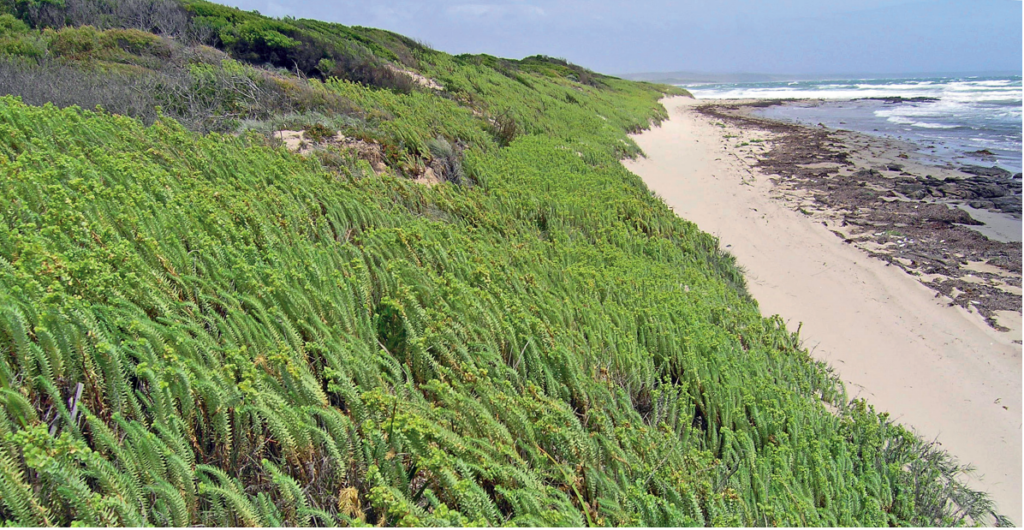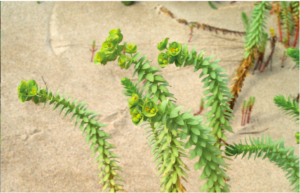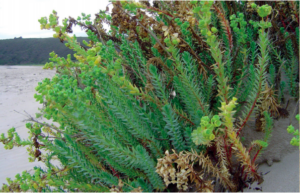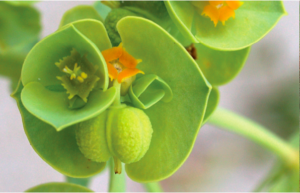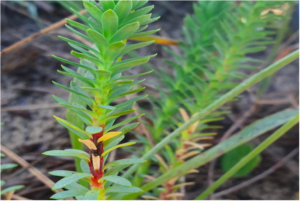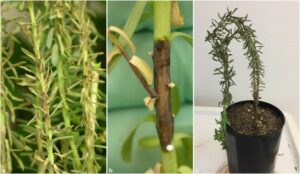Turning the Tides on Sea Spurge
Sea Spurge (Euphorbia paralias) is undoubtably one of the most prolific coastal weeds in Tasmania. Many Wildcare Tasmania groups work along Tasmania’s coastline, and have spent countless hours battling the ever-present sea spurge. If you follow the work of Wildcare, you’ve probably heard your fair share of sea spurge news. However, following a new development from the CSIRO, the tides may be turning against sea spurge…
About Sea Spurge
Sea spurge is native to many countries from northern Africa, Europe, and western Asia. A coastal plant, sea spurge usually grows to 20 to 70 centimetres tall but occasionally grows to one metre. The plant has multiple stems, usually less than 10 but sometimes with up to 100. Surveys from Tasmania and New South Wales have shown that sea spurge can reach densities of 150,000 to 180,000 plants per hectare. Each plant can produce up to 5000 seeds which may survive for several years on ocean currents.
Impacts
Sea spurge is a relentless force that will reinvade after mass removal and without intervention will continue to progress forward. Sea spurge is a serious threat to coastline biodiversity. The weed removes suitable habitat for species of shorebirds, including the threatened hooded plover. Sea spurge also outcompetes native species of flora which are critical components of the landscape which support geomorphic processes of the coastline. The plant can also cause skin and eye irritations in those who inadvertently touch its milky latex sap.
Not a lost cause
The good news is that almost anywhere you’re likely to find sea spurge, you’re likely to find a Wildcare volunteer or two! Over Wildcare’s history an unfathomable number of plants have been removed. Some key highlights are:
- In 2019 the Friends of the Larapuna Coast removed 11,000 plants in three short days.
- In early 2021 Friends of Narawntapu president Helen Plaister, reported that her team has noticed shorebirds returning to small sections of coastline that have been cleared of sea spurge.
- Wildcare SPRATS (our very own specialised sea spurge removal team) recorded the removal of over 14 million plants, over 15 years!
New development in sea spurge management
The CSIRO has been testing a new method of controlling sea spurge – a fungus called Venturia paralias from the weed’s native habitat in France. CSIRO researcher Dr Gavin Hunter has been testing it since 2017.
“Initially the fungus infects the leaves, which can create a lesion on the leaf, but more importantly it can move from there into the stem. Once in the stem, it produces a characteristic dark lesion on the stem, which makes it very difficult for the plant to transport water up and down the stem.”
Various stages of Venturia paralias attacking sea spurge (Photos, CSIRO, Hunter et al)
Dr Hunter has stated that there is no chance of the fungus attacking other plants (full report on field testing).
“Our testing has occurred over a period of a few years: We’ve tested it against a large number of related species. We’ve found it to be highly specific”
Venturia paralias has been released on three Tasmanian separate beaches as part of the pilot program to test if it would spread and thrive in Australian conditions.
Sea spurge numbers under control on Deal Island, thanks to volunteer efforts (Margot Foster)
Perhaps we will one day see a sea spurge free Tasmania! Please consider supporting our Coastal Conservation Cause to help us to continue to care for Tasmania’s coast.
